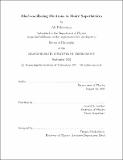Bloch-oscillating Electrons in Moiré Superlattices
Author(s)
Fahimniya, Ali
DownloadThesis PDF (8.133Mb)
Advisor
Levitov, Leonid S.
Terms of use
Metadata
Show full item recordAbstract
The extremely narrow bands in moiré materials harbor surprising transport regimes not accessible in other materials. As discussed in this thesis, a large superlattice periodicity and narrow bandwidth create an appealing setting for realizing and probing electronic Bloch oscillations. A key property of Bloch oscillations of electrons in moiré systems is their two-dimensional character, described by several incommensurate frequencies rather than a single frequency. Crucially, although the frequencies of these oscillations are identical for all carriers in the system, the oscillations of different carriers are asynchronous, i.e., out of phase. The oscillation frequencies being equal for a macroscopically large number of carriers enables various exciting effects, e.g., a comb-like spectrum of emitted electric noise with resonances near the Bloch frequencies and a strong response under an AC field near these frequencies. Furthermore, moiré systems present an appealing opportunity for achieving phase-coherent collective oscillations. To that end, we outline a synchronization scheme based on coupling the Bloch-oscillating electrons to an oscillator mode in a THz resonator. We also discuss Bloch oscillations in the presence of a magnetic field. The competition between Bloch oscillations and the cyclotron motion of electrons gives rise to interesting dynamical effects. We identify distinct phases that occur depending on the relative strength of the electric and magnetic fields. The Hall current, which undergoes a sharp drop at the transition between the electric and the magnetic regimes, can serve as a diagnostic of magnetic Bloch oscillations. The appealing properties of Bloch-oscillating moiré bands single out these systems as a promising candidate for achieving and exploring Bloch oscillations in solids, a long-sought-after collective many-body behavior.
Date issued
2021-09Department
Massachusetts Institute of Technology. Department of PhysicsPublisher
Massachusetts Institute of Technology